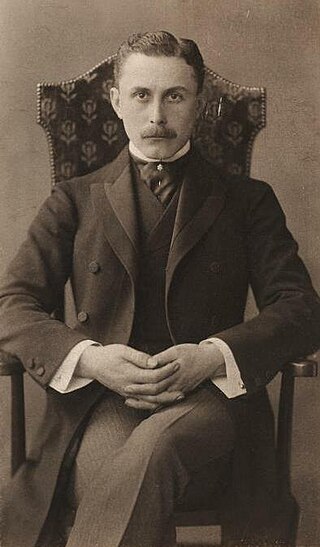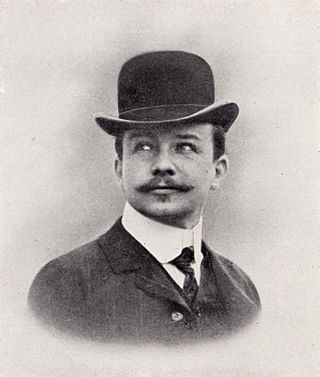
Gustav Klimt was an Austrian symbolist painter and one of the most prominent members of the Vienna Secession movement. Klimt is noted for his paintings, murals, sketches, and other objets d'art. Klimt's primary subject was the female body, and his works are marked by a frank eroticism. Amongst his figurative works, which include allegories and portraits, he painted landscapes. Among the artists of the Vienna Secession, Klimt was the most influenced by Japanese art and its methods.

Adolf Franz Karl Viktor Maria Loos was an Austrian and Czechoslovak architect, influential European theorist, and a polemicist of modern architecture. He was inspired by modernism and a widely-known critic of the Art Nouveau movement. His controversial views and literary contributions sparked the establishment of the Vienna Secession movement and postmodernism.

Otto Koloman Wagner was an Austrian architect, furniture designer and urban planner. He was a leading member of the Vienna Secession movement of architecture, founded in 1897, and the broader Art Nouveau movement. Many of his works are found in his native city of Vienna, and illustrate the rapid evolution of architecture during the period. His early works were inspired by classical architecture. By mid-1890s, he had already designed several buildings in what became known as the Vienna Secession style. Beginning in 1898, with his designs of Vienna Metro stations, his style became floral and Art Nouveau, with decoration by Koloman Moser. His later works, 1906 until his death in 1918, had geometric forms and minimal ornament, clearly expressing their function. They are considered predecessors to modern architecture.

The Vienna Secession is an art movement, closely related to Art Nouveau, that was formed in 1897 by a group of Austrian painters, graphic artists, sculptors and architects, including Josef Hoffman, Koloman Moser, Otto Wagner and Gustav Klimt. They resigned from the Association of Austrian Artists in protest against its support for more traditional artistic styles. Their most influential architectural work was the Secession exhibitions hall designed by Joseph Maria Olbrich as a venue for expositions of the group. Their official magazine was called Ver Sacrum, which published highly stylised and influential works of graphic art. In 1905 the group itself split, when some of the most prominent members, including Klimt, Wagner, and Hoffmann, resigned in a dispute over priorities, but it continued to function, and still functions today, from its headquarters in the Secession Building. In its current form, the Secession exhibition gallery is independently led and managed by artists.

Joseph Maria Olbrich was an Austrian architect and one of the Vienna Secession founders.

Koloman Moser was an Austrian artist who exerted considerable influence on twentieth-century graphic art. He was one of the foremost artists of the Vienna Secession movement and a co-founder of Wiener Werkstätte.

The Wiener Moderne or Viennese Modernism is a term describing the culture of Vienna in the period between approximately 1890 and 1910. It refers especially to the development of modernism in the Austrian capital and its effect on the spheres of philosophy, literature, music, art, design and architecture.

The Stoclet Palace is a mansion in Brussels, Belgium. It was designed by the Austrian architect Josef Hoffmann for the Belgian financier Adolphe Stoclet. Built between 1905 and 1911 in the Vienna Secession style, it is located at 279–281, avenue de Tervueren/Tervurenlaan, in the Woluwe-Saint-Pierre municipality of Brussels. Considered Hoffman's masterpiece, the residence is one of the 20th century's most refined and luxurious private houses.

Portrait of Adele Bloch-Bauer I is an oil painting on canvas, with gold leaf, by Gustav Klimt, completed between 1903 and 1907. The portrait was commissioned by the sitter's husband, Ferdinand Bloch-Bauer, a Viennese and Jewish banker and sugar producer. The painting was stolen by the Nazis in 1941 and displayed at the Österreichische Galerie Belvedere. The portrait is the final and most fully representative work of Klimt's golden phase. It was the first of two depictions of Adele by Klimt—the second was completed in 1912; these were two of several works by the artist that the family owned.

Josef Hoffmann was an Austrian-Moravian architect and designer. He was among the founders of Vienna Secession and co-establisher of the Wiener Werkstätte. His most famous architectural work is the Stoclet Palace, in Brussels, (1905–1911) a pioneering work of Modern Architecture, Art Deco and peak of Vienna Secession architecture.

Joseph Leo Koerner is an American art historian and filmmaker. He is the Victor S. Thomas Professor of the History of Art and Architecture and Professor of Germanic Languages and Literatures at Harvard University. Since 2008 he has also been Senior Fellow at the Harvard's Society of Fellows.

Erwin Puchinger was a Viennese painter, illustrator, industrial designer and graphic artist. He was an influential figure in Viennese art in the fin-de-siecle. Puchinger was a part of the Austrian Jugendstil and Gesamtkunstwerk movements, which sought to erase the boundaries between fine art and applied art. Puchinger worked in London, Prague and Paris as well as Vienna and collaborated with other major figures in Viennese art and design such as Ernst and Gustav Klimt and Otto Prutscher. He was a respected art professor at the Graphic Arts Institute, where he taught for more than thirty years. His work was also part of the painting event in the art competition at the 1936 Summer Olympics.

The Vienna Museum is a group of museums in Vienna consisting of the museums of the history of the city. In addition to the main building in Karlsplatz, the group includes some locations, numerous specialised museums, musicians' residences and archaeological excavations.

Alfred Roller was an Austrian painter, graphic designer, and set designer. His wife was Mileva Roller and they were members of the Viennese Secession movement.
Henry Koerner was an Austrian-born American painter and graphic designer best known for his early Magical Realist works of the late 1940s and his portrait covers for Time magazine.

Café Museum is a traditional Viennese café located in the Innere Stadt first district in Vienna. The café opened in 1899. The original interior was designed by renowned architect Adolf Loos. The café became a meeting place for Viennese artists.

Edmund Engelman was a Jewish Austrian (Viennese), and later American, photographer and engineer who became famous for photographing the home and workplace of Sigmund Freud at Berggasse 19 in Vienna, shortly before the Freud family escaped Austria for England in 1938.
The Gallia family Hoffman apartment collection is a set of furniture and decorative objects that are the surviving Vienna Secession style contents of the 1913 apartment of wealthy businessman Moritz Gallia and his wife and Hermine, mostly designed by leading architect and designer Josef Hoffman. When the Gallia's children had to flee the Anschluss with Nazi Germany in 1938, they brought what remained with them to Australia, a place 'as far away as they could get', where it was subsequently purchased in 1976 by National Gallery of Victoria, and pieces have been on permanent display since 1984.
The Kunstschau Wien 1908 was an art and craft exhibition held from June 1 to November 16, 1908, on the grounds of what became the Wiener Konzerthaus in Vienna, Austria. The show was one of dozens of events and festivities marking the 60th anniversary of the reign of Emperor Franz Joseph I. It was organized by Austrian artist Gustav Klimt and the community of avant-garde artists surrounding him, including most notably Koloman Moser, Alfred Roller, Carl Otto Czeschka, Otto Prutscher, and Josef Hoffmann. Despite organizing the workshop, considered to be a groundbreaking showcase of Viennese modernism, Klimt and his colleagues were not invited to the formal, official, celebrations.

The Duchess of Montesquiou-Fezensac is a 1910 oil portrait by Oskar Kokoschka. In this expressionist work Kokoschka strove to capture the essence of his sitter, a young noblewoman afflicted with tuberculosis, with somber tones and stylized gestures. Among his early portraits, Kokoschka considered the work his most valuable, and as his first work to be acquired by a museum it played a key role in establishing the young artist's reputation. During the Nazi period it was confiscated from the Museum Folkwang in Essen and pilloried in the Degenerate Art exhibition before being auctioned off. It is currently in the collection of the Cincinnati Art Museum.

















